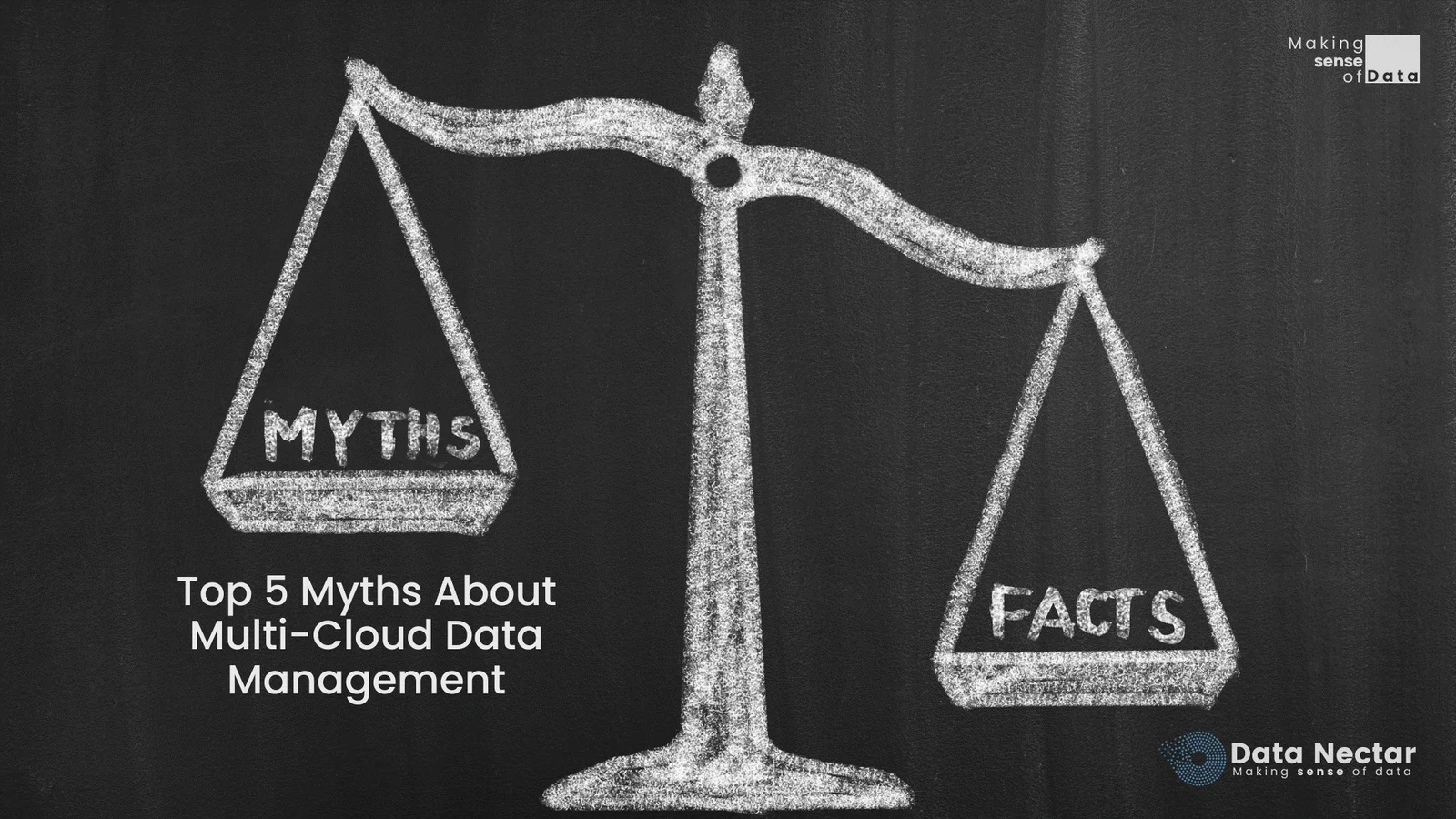In today’s rapidly evolving business landscape, many organizations are turning to multi-cloud data management as a way to improve their flexibility, reduce vendor lock-in, and increase resilience.
Multi-cloud data management refers to the practice of using multiple cloud data management service providers to store and manage data, rather than relying on a single provider. While the benefits of multi-cloud data management are clear, there are still many myths and misconceptions surrounding this approach that can deter organizations from adopting it.
In this post, we will address seven common myths about multi-cloud data management and debunk them with facts and examples. We will explain why multi-cloud data management is not too complex, too expensive, or too insecure, and why it does not require specialized expertise or only benefit large enterprises or certain industries.
By the end of this post, we hope to dispel these myths and encourage organizations to embrace multi-cloud data management as a way to improve their operations and gain a competitive edge in their industry.
Find the Top 5 myths about multi-cloud Data Management:
Myth #1: Multi-cloud data management is too complex
Some organizations believe that managing data across multiple cloud providers will require too much time, resources, and expertise. However, managing data across multiple clouds can be just as simple or complex as managing a single cloud environment.
With the right tools and strategies in place, organizations can successfully manage their data across multiple clouds and reap the benefits that come with it. Real-world examples, such as Dropbox’s migration from AWS to GCP, demonstrate the feasibility of multi-cloud data management.
Myth #2: Multi-cloud data management is too expensive
The myth suggests that managing data across multiple cloud platforms is cost-prohibitive for businesses, as it requires significant investment in infrastructure, software, and personnel.
Debunking the myth with facts and examples:
Contrary to popular belief, multi-cloud data management can actually be more cost-effective than relying on a single cloud provider. Here are some facts and examples to debunk the myth.
- Avoid vendor lock-in: By utilizing multiple cloud providers, businesses can avoid vendor lock-in and negotiate better pricing and terms with each provider. This can result in significant cost savings over the long run.
- Flexibility and scalability: Multi-cloud environments allow businesses to scale their operations up or down quickly, based on their needs. This can lead to cost savings by avoiding unnecessary infrastructure and personnel costs.
- Competitive pricing: Cloud providers are constantly competing with each other, which can result in lower pricing and better deals for businesses.
- Use of open-source tools: Open-source tools and software can be used to manage multi-cloud environments, reducing the need for expensive proprietary software.
For example, Netflix uses a multi-cloud approach to manage its vast amount of data, which has helped the company avoid downtime and reduce costs. Similarly, Adobe uses a combination of AWS, Microsoft Azure, and Google Cloud Platform to manage its operations, allowing the company to be more agile and cost-effective.
In conclusion, multi-cloud data management can be a cost-effective solution for businesses, providing flexibility, scalability, and the ability to negotiate better pricing and terms with cloud providers.
Myth #3: Multi-cloud data management is not secure
This myth suggests that managing data across multiple cloud platforms increases security risks, making it difficult to maintain a consistent security posture across all environments. Businesses may also worry that data breaches or cyber-attacks on one cloud platform could compromise data across all platforms.
Debunking the myth with facts and examples:
Multi-cloud data management can actually enhance security for businesses. Here are some facts and examples to debunk the myth:
- Diversification of risk: By utilizing multiple cloud providers, businesses can diversify their risk and reduce the impact of any potential security breaches or downtime. If one cloud provider experiences a security breach, the impact will be limited to that provider’s environment, and data in other environments will remain safe.
- Best-of-breed security: Each cloud provider has its own unique security features and strengths. By using multiple providers, businesses can leverage the best security features of each provider, creating a more robust and secure overall environment.
- Centralized security management: Multi-cloud environments can be managed through a centralized security management platform, allowing businesses to maintain a consistent security posture across all environments.
- Compliance requirements: Some industries, such as healthcare and finance, have strict compliance requirements that must be met to ensure data privacy and security. Multi-cloud environments can provide businesses with the flexibility to meet these requirements while still leveraging the benefits of cloud technology.
For example, Capital One uses a multi-cloud approach to manage its operations, which has helped the company enhance security and reduce risk.
Similarly, the state of Arizona has adopted a multi-cloud strategy to enhance security and compliance across its various agencies.
In conclusion, multi-cloud data management can actually enhance security for businesses, providing diversification of risk, best-of-breed security features, centralized security management, and the flexibility to meet compliance requirements.
Myth #4: Multi-cloud data management requires specialized expertise
This myth suggests that managing data across multiple cloud platforms is a complex and technical process that requires specialized expertise. Businesses may worry that they do not have the necessary technical skills or resources to manage data across multiple cloud platforms effectively.
Debunking the myth with facts and examples:
Multi-cloud data management can be managed effectively without specialized expertise. Here are some facts and examples to debunk the myth:
- Cloud service providers offer managed services: Cloud service providers offer managed services that can help businesses manage their multi-cloud environments. These services include automated provisioning, monitoring, and management of cloud resources, making it easier for businesses to manage their multi-cloud environments without specialized expertise.
- Tools and platforms: There are various tools and platforms available that make managing multi-cloud environments easier. These tools provide centralized management, automation, and orchestration of resources, making it easier for businesses to manage their multi-cloud environments.
- Training and support: Cloud service providers offer training and support to help businesses manage their multi-cloud environments effectively. They also offer online resources, documentation, and best practices to help businesses manage their multi-cloud environments.
For example, Cisco’s CloudCenter Suite is a platform that helps businesses manage multi-cloud environments. It provides a single interface to manage cloud resources across multiple cloud platforms, including AWS, Azure, Google Cloud, and VMware.
Similarly, Microsoft’s Azure Arc is a management platform that allows businesses to manage resources across different cloud platforms, including AWS and Google Cloud.
In conclusion, multi-cloud data management does not require specialized expertise. Cloud service providers offer managed services, tools and platforms, training, and support to help businesses manage their multi-cloud environments effectively. With the right resources and tools, businesses can effectively manage their multi-cloud environments without specialized expertise.
Myth #5: Multi-cloud data management is only for large enterprises
This myth suggests that managing data across multiple cloud platforms is only practical and affordable for large enterprises. Small and medium-sized businesses (SMBs) may worry that managing multiple cloud environments is too expensive or complicated for their needs.
Debunking the myth with facts and examples:
Multi-cloud data management can be practical and affordable for businesses of all sizes. Here are some facts and examples to debunk the myth:
- Cost-effective solutions: Cloud service providers offer cost-effective solutions for businesses of all sizes. Cloud providers offer pay-as-you-go pricing models that allow businesses to only pay for the resources they use, making it more cost-effective for small and medium-sized businesses to manage their multi-cloud environments.
- Flexibility: Multi-cloud environments provide businesses with the flexibility to choose the cloud platform that best suits their needs. Small and medium-sized businesses can choose to use a combination of public and private clouds, depending on their needs, making multi-cloud data management more practical for them.
- Competitive advantage: Multi-cloud data management can provide businesses with a competitive advantage by allowing them to choose the best cloud platform for each workload, optimizing performance and cost-effectiveness. This can be especially important for small and medium-sized businesses that need to be agile and responsive to market demands.
For example, Infor, a global enterprise software company, uses multi-cloud data management to provide its customers with more flexibility and cost-effectiveness. Similarly, a small e-commerce business may use a combination of public and private clouds to manage its online store, depending on its needs.
In conclusion, multi-cloud data management is not just for large enterprises. Cloud service providers offer cost-effective solutions, flexibility, and competitive advantage to businesses of all sizes. By leveraging multi-cloud data management, small and medium-sized businesses can optimize their cloud environments for their needs and gain a competitive advantage.
Conclusion:
In conclusion, the five myths surrounding multi-cloud data management are often based on misconceptions and outdated assumptions. Businesses should not be deterred from adopting a multi-cloud approach due to these myths. Instead, they should consider the benefits of multi-cloud data management, such as diversification of risk, best-of-breed security features, centralized management, cost-effectiveness, and flexibility. By adopting a multi-cloud strategy, businesses of all sizes can optimize their cloud environments to meet their specific needs, gain a competitive advantage, and ultimately, drive their success.


















